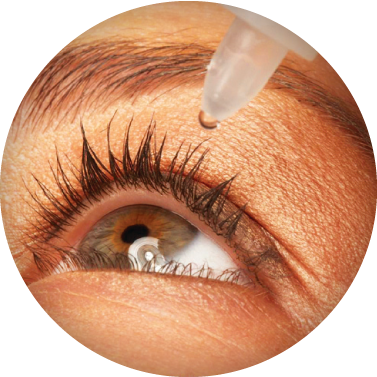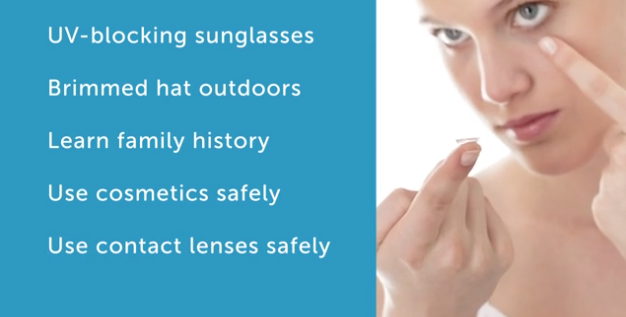 We use our eyes almost every waking moment of our lives. They are literally our windows to the world around us. So why do so many of us neglect proper eye care? Taking our vision for granted, many things we do—or don’t do—can have long-lasting effects on our eye health.
We use our eyes almost every waking moment of our lives. They are literally our windows to the world around us. So why do so many of us neglect proper eye care? Taking our vision for granted, many things we do—or don’t do—can have long-lasting effects on our eye health.
Why Women Need to Worry About Eye Health
A 2012 study, Vision Problems in the US, found that 66 percent of subjects who were experiencing blindness were women. Sixty-one percent of those with cataracts were female. Finally, women comprised 65 percent of those with Age-Related Macular Degeneration (AMD). “Women are simply more intrinsically affected because they often live much longer than men,” said opthamologist Dr. Mildred Olivier, of Midwest Glaucoma Center, in an interview with The Mind-Body Shift. Age-related conditions, such as cataracts, AMD and Fuchs endothelial corneal disease are therefore more common in women. Additionally, women are more likely to have autoimmune disease, like lupus, which can also increase the risk of certain eye diseases. “Sometimes it’s frankly also access—we take care of everyone else but ourselves. We make sure the kids get to their appointment,” Olivier said, but women often neglect to follow-through on their own care.
Dealing with Dry Eyes
As estrogen decreases with age, women are more prone to dry eye syndrome. Certain medications, such as Tamoxifin for breast cancer, can also cause dry eye. This can be quickly alleviated with the use of artificial tears eye drops, and medications like Restasis can increase the eye’s ability to produce of tears. Olivier also says dry eye syndrome can also be addressed with a cyclosporine ophthalmic solution twice a day.
Screening Eyes from the Sun
Ultraviolet light can increase conditions such as cataracts and macular degeneration, which are found in the corners of the eye, places that have more sun than the others, according to Olivier. Wearing sunglasses and hats are recommended to reduce the risk of these conditions.
How Diet Affects Your Eyes
Having diabetes can also affect your eye health. “There’s a chance of changes in anyone with uncontrolled diabetes for period of time,” said Olivier. It takes approximately 10 to 15 years before diabetes can affect the back of the eye. However this is largely dependent on a person’s control over the blood sugar.
“Individuals should know their A1c level. This blood test is simple and ordered by their primary care physician,” she said. “We want this level to be between 5 and 6. The better controlled the blood sugar and consistently low the A1c level is, the less likely diabetes can affect the back of the eye.”
Diet and exercise play a big role in helping to control blood sugar, blood pressure and cholesterol.
The Nurses’ Health Study, a retrospective study of nearly 80,000 women over 26 years, found that those who ate more antioxidant-rich foods—including leafy greens, like kale and collards—were less disposed to glaucoma. According to the BrightFocus Foundation, there was also a decreased risk of glaucoma in African-American women, with higher intake of antioxidant rich fruits and vegetables high in vitamin A, vitamin C, and carotenoids. African Americans also have a higher prevalence of glaucoma at a younger age, while Hispanics see an increased risk over the age of 60.
The BrightFocus Foundation states that glaucoma, which leads to damage of the optic nerve and can potentially cause vision loss, is a leading cause of blindness among African Americans and Hispanics. Individuals with myopia (nearsightedness), trauma, family history of glaucoma, or those who have had chronic steroid use for conditions—such as rheumatoid arthritis or allergies—are also at greater risk.
“Other factors, such as access to care and insurance, can delay going to the doctor. So the point of entry into the health care system may detect advanced disease,” Olivier said. “Primary Open Angle Glaucoma does not have any symptoms, so if one waits until they have difficulty seeing, the disease has often progressed.”
How Cosmetics and Contacts Affect the Eye
Oliver offers this advice to contact wearers:
• Don’t sleep in them or wear them all day and night.
• Make sure your eyes breathe.
• Make sure contacts are properly fitted and aren’t too tight or too loose. Store them properly with proper solution.
• The optic nerve can be irritated even more when wearing contacts with very dry eyes, especially when warm heat is blowing on them, when it’s allergy season and when it’s humid. Folks with dry eyes might want to reconsider contact use.
• Wash your hands before you put them in or take them out. Improper contact lens care can lead to developing Fusarium keratitis or Acanthamoeba keratitis, fungal infections that can lead to corneal scarring or blindness.
Contact lens wearers are considered to have the highest risk for developing acanthamoeba keratitis, likely caused by eye exposure to water contaminated with the amoeba Acanthamoeba, a free-living organism. Wearing dirty contact lenses, using contaminated tap or well water to clean contact lenses, storing or cleaning contact lenses in a homemade solution and wearing contact lenses in a hot tub, pool, or in the shower, can all increase the risks of developing these painful and dangerous health conditions.
To reduce the risks of these fungal infections, Olivieri recommends:
• Follow doctor’s directions for the care and cleaning of your contact lenses.
• Never use tap water to clean your contact lenses.
• Do not swim, shower or hot tub while wearing contact lenses, without goggles.
• Soak contact lenses in fresh disinfecting each night.
• Wash hands before handling contact lenses.
• Always clean contact lenses immediately upon removal • See your eye specialist at the recommended intervals, and see an eye specialist immediately if you develop a red eye.
Cosmetics and Contacts Eye Safety
Ladies, also please be careful with your makeup!
“One should take care in applying anything around the eye so that the cornea does not get scratched,” said Olivier. ”I sometimes see particles of mascara in the eye, but this is transient and often not large enough to cause any problems.”
Most of the time, flakes fall out when the eye forms tears. However, Olivier advises that if one feels discomfort in the eyes, she should discontinue the practice that caused it.
“We probably should do more studies on certain type of makeup, how products like mascara and eyeliner affect the eye,” she said. “Almost half of medical school staff are women. We can start asking those kinds of questions. What do these glaucoma drugs do? What do these products that we put around our eye do over time?”
Olivier recommends that people regularly get their eyes examined. “As you get older, go more regularly. When you’re younger, your doctor can decide if you need to be seen once or every other year,” she said. Diabetics should see a dilated exam every year, so doctors can take a good look at the back of the eye.
An educational campaign dedicated solely to women’s vision health, See Jane See – Women’s Healthy Eyes Now, first launched last October. See Jane See offers free education and tips specifically for women about dry eye, cosmetics safety, pregnancy, vision and nutrition, and age-relayed eye disease. Readers can also learn about the symptoms, causes and treatment for a variety of eye-related conditions at seejanesee.preventblindness.org

Very informative! My mother has Macular Degeneration, I have dry eye, and my husband is Diabetic. Your article touches upon many aspects of eye concerns and care. Thank you for sharing this important information. CT
I’m glad you found this informative. My mother was recently diagnosed with cataracts, and I suffer from dry eye myself. Thanks so much for reading and commenting! -RC